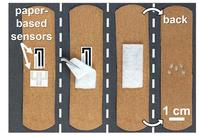Low-cost “smart bandages” wirelessly monitor open wound status


Chronic wounds - wounds that do not heal within 3 months - currently affect 6.5 million people in the U.S. Chronic wound patients' quality of life is significantly reduced because their damaged tissue is susceptible to bacterial infections. Treatments of chronic wounds are often very expensive, requiring periodic inspection by doctors or nurses to check for signs of infections hindering the wound healing process. In addition, current monitoring methods are often bulky, frightening to child patients, and can only be applied by trained personnel.
The FlexiLab, a research group led by Ramses Martinez, assistant professor of industrial engineering and biomedical engineering, has developed low-cost "smart bandages" (Omniphobic Paper-Based Smart Bandage or OPSBs) capable of monitoring the status of chronic wounds in real time. When these smart bandages detect the proliferation of bacteria in open wounds, they send an alarm message using WiFi signals to both the patient and the doctor - via any modern phone, tablet, smart watch, or laptop - in order for them to change the bandage and disinfect the wound.
The base of the smart bandage is a generic bandage that can be purchased at any local store. The wireless electronics interfacing the sensors inside the bandages look like a "smiley face", making it particularly easy to use this technology with child patients. This "smiley face" circuit is non-threatening to children, lightweight and wirelessly rechargeable. The circuit is also economical because it can be re-used many times after peeling it off the bandage, sterilizing it, and re-attaching it to a new bandage during a dressing change.
The smart bandages perform electrochemical tests to estimate the pH and the concentration of uric acid, since those parameters are key indicators of bacterial proliferation on open wounds. Additionally, the smart bandages can also perform impedance spectroscopy on closed wounds like pressure ulcers to assess tissue damage in real time, automatically informing nurses and doctors when it is time to change the position of an in-bed patient.
These paper-based smart bandages are inexpensive to fabricate and can be easily disposed by burning, leaving no medical waste. The flexible sensors in the bandage ensure its conformability to the wound, so that it can be worn without any discomfort. The researchers envision furthering the capabilities of these smart bandages to perform other point-of-care diagnostics at a low cost.
The research was recently published in Biosensors and Bioelectronics in the article "Early detection and monitoring of chronic wounds using low-cost, omniphobic paper-based smart bandages."
Source: Low-cost “smart bandages” wirelessly monitor open wound status
